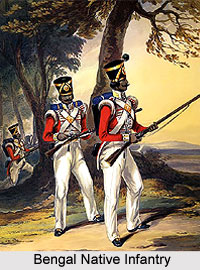 The 17th Regiment of Bengal Native Infantry was primarily an infantry battalion of the British East India Company, which existed from the year 1858 to 1922. It was a part of the Bengal Native Infantry under the Army of the Bengal province, before the commencement of the Great Revolt of 1857. The Bengal Army was the armed forces of Bengal Presidency and was amongst the 3 main Presidency Armies in British India. Later it became a part of the United British Indian Army. King Edward VII acted as the Colonel-in-Chief of the battalion in the year 1904.The army unit was also incorporated as a part of the Bengal Command. The 17th Regiment of Bengal Native Infantry was also known as the 17th Infantry (The Loyal Regiment).
The 17th Regiment of Bengal Native Infantry was primarily an infantry battalion of the British East India Company, which existed from the year 1858 to 1922. It was a part of the Bengal Native Infantry under the Army of the Bengal province, before the commencement of the Great Revolt of 1857. The Bengal Army was the armed forces of Bengal Presidency and was amongst the 3 main Presidency Armies in British India. Later it became a part of the United British Indian Army. King Edward VII acted as the Colonel-in-Chief of the battalion in the year 1904.The army unit was also incorporated as a part of the Bengal Command. The 17th Regiment of Bengal Native Infantry was also known as the 17th Infantry (The Loyal Regiment).
History of 17th Regiment of Bengal Native Infantry
The 17th Regiment of Bengal Native Infantry was established at Phillour by Major J. C. Innes in the year 1858. It was formed with the troops of the regiments of 3rd, 36th and 61st Bengal Native Infantry. These infantry regiments provided loyal service to the British East India Company during the Great Revolt of 1857, also known as Sepoy Mutiny. The unit was later assigned The Loyal Purbiah Regiment.
Designations of 17th Regiment of Bengal Native Infantry
The 17th Infantry (The Loyal Regiment) battalion of the British Indian Army occupied several designations through out its existence. These are mentioned below-
* 17th Regiment of Bengal Native Infantry (1861)
* 17th Regiment of Bengal Native Infantry- The Loyal Purbiah (1864)
* 17th Regiment of Bengal Infantry- The Loyal Purbiah (1885)
* 17th Regiment of Bengal Infantry- The Loyal Regiment (1898)
* 17th Musalman Rajput Infantry- The Loyal Regiment (1902)
In the year 1903, the 17th Regiment of Bengal Native Infantry was designated for the last time, when the titles of the British Indian presidencies were omitted after the Kitchener reforms of the British Indian Army.
Operations of 17th Regiment of Bengal Native Infantry
The regiment of Bengal of Army provided significant service at various operations, such as the Battle of Tofrek, the Second Anglo Afghan War, the capture of Suakin in the Sudan Campaign and the First World War. The 17th Regiment of Bengal Native Infantry was part of the 22nd Lucknow Infantry Brigade during First World War. It was initially attached to the 8th Lucknow Division in British India to perform duties of internal security. The Battalion was later became a part of the 11th Indian Division in Egypt.
Dissolution of 17th Regiment of Bengal Native Infantry
After the culmination of the First World War, the British Government of India restructured and re-organized the Indian army. The separate single battalion infantry regiments were merged together in order to develop more prominent multi battalion regiments. As a result, the 17th Regiment of Bengal Native Infantry was dissolved in the year, along with 9 other regiments.



















